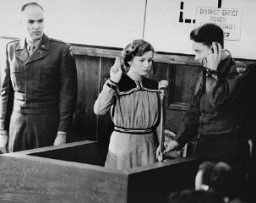You searched for: 江苏谷歌seo公司【TG飞机:@bapingseo】阿里国际站被谷歌收录【TG电报:@bapingseo】五分菲律宾快三邀请码导师带计划稳赚【Telegram:@bapingseo】彩43下载飞艇回血厉害老师简单秘籍5000本金怎么回血25万?20220708Sw3Jak.html
<< Previous | Displaying results 76-100 of 253 for "江苏谷歌seo公司【TG飞机:@bapingseo】阿里国际站被谷歌收录【TG电报:@bapingseo】五分菲律宾快三邀请码导师带计划稳赚【Telegram:@bapingseo】彩43下载飞艇回血厉害老师简单秘籍5000本金怎么回血25万?20220708Sw3Jak.html" | Next >>
-
Vita Rivkina
ID CardBecause both of her parents had died by the time Vita was 5 years old, she went to live with her cousins. At the age of 18, Vita married Iosif Rivkin, and the couple moved to Minsk where they raised three daughters--Hacia, Dora and Berta. 1933-39: By the early 1930s, the Rivkin family lived on Novomesnitskaya Street in central Minsk, near the Svisloch River. In the 1930s the girls attended Soviet state schools and were members of the Soviet youth organization, Young Pioneers. By the late 1930s Minsk was…

-
Moshe Galek
ID CardMoshe was one of eight children born to Jewish parents in Sochocin, a predominantly Catholic village near Warsaw. Moshe was a self-made man, having founded a successful pearl-button factory in the village. While in his thirties, he married Fela Perznianko, the daughter of a prominent attorney from nearby Zakroczym. He brought his new wife to Sochocin, where they raised four daughters. 1933-39: In 1936 the Galeks moved to Warsaw, attracted by the city's cultural life. When Germany invaded Poland on…
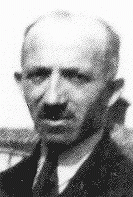
-
Mara Jovicic Popovic
ID CardMara was one of six children born to Serbian parents. The family lived in the small town of Foca in the region of Bosnia. Like her parents, Mara was baptized in the Serbian Orthodox faith. She grew up in Foca and in the Bosnian capital of Sarajevo, where she completed secondary school. In 1930 she married Rajko Popovic, a circuit court judge. The couple had no children. 1933-39: In 1934 Rajko completed a judicial tour of duty in Foca, and the couple moved to Sarajevo, the capital of Bosnia. Mara and Rajko…

-
Grietje Polak
ID CardGrietje was born to a large religious Jewish family in Amsterdam. When she was in her mid-20's, she married Frederik Polak, an accountant. The Polaks had a son, Jacob, and three daughters, Julia, Betty and Liesje. They lived in simple quarters on the second floor of a house. 1933-39: Creating an atmosphere of Jewish observance in the home was important to Grietje and her husband. They loved to celebrate the Sabbath and the Jewish holidays with their four children. Grietje taught shorthand and needlepoint…

-
Hans Rudelsheim
ID CardHans was born to a Jewish family in the small Dutch town of Kampen. His father worked as a tailor, and he taught Hans about the tailoring trade. 1933-39: Hans was a skilled tailor, and an accomplished pianist as well. Inquisitive about all subjects, Hans loved to read and to keep abreast of current events. 1940-43: When the Jews in the Dutch provinces were ordered to relocate to Amsterdam in January 1942, the Rudelsheims complied. In early 1943, while in hiding with a Christian family near Leiden, Hans…
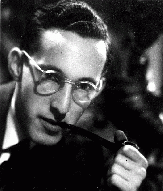
-
Sarah Judelowitz
ID CardSarah, born Sarah Gamper, was one of four children born to a Jewish family in the Baltic port city of Liepaja. Her parents owned a general store there. At the outbreak of World War I, Sarah was studying piano at a conservatory in Russia. During World War I, she remained there to serve as a nurse. She returned to Liepaja, and after marrying Herman Judelowitz in 1920, settled there. 1933-39: Sarah and Herman operated a shoe store in the front of their small shoe workshop. By 1935 they had three daughters,…
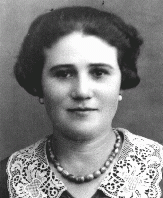
-
Polish Victims
ArticleIn September 1939, the Germans launched a campaign of terror intended to destroy the Polish nation and culture. Learn more about the German occupation of Poland.

-
Registration certificate issued to Mikulas Diamant (outside)
DocumentThe Slovak National Council for Social Solicitude issued this registration certificate to Mikulas Diamant on July 25, 1945, in Bratislava, Czechoslovakia. This view shows the front and back cover. The certificate ensured repatriation and safe return home.

-
Evidence Tag
ArtifactEvidence tag from the trial of Klaus Barbie in Lyon, France. This standard police form lists Barbie's infractions as crimes against humanity and complicity, concepts defined at the International Military Tribunal at Nuremberg decades earlier. The line in which the victims' names would be recorded is left blank. February 25, 1983.

-
Evidence Tag
ArtifactEvidence tag from the trial of Klaus Barbie in Lyon, France. This standard police form lists Barbie's infractions as crimes against humanity and complicity, concepts defined at the International Military Tribunal at Nuremberg decades earlier. The line in which the victims' names would be recorded is left blank. February 25, 1983.
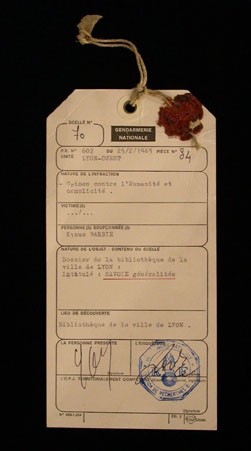
-
French leader Charles de Gaulle in London
PhotoFrench leader Charles de Gaulle in London after France signed an armistice with Germany on June 22, 1940. De Gaulle refused to accept the armistice and led the Free France resistance movement. London, Great Britain, June 25, 1940.
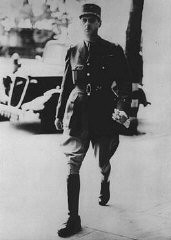
-
Judges in the trial of Dora-Mittelbau personnel
PhotoJudges in the trial of 19 men accused of committing atrocities at the Dora-Mittelbau concentration camp, located near Nordhausen. Dachau, Germany, September 25, 1947.
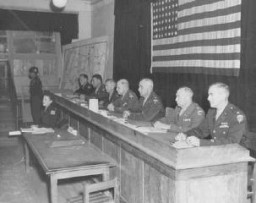
-
World War II in Eastern Europe, 1942–1945
ArticleBefore 1942, Nazi Germany had expanded across much of Europe. Learn more about major Allied victories in eastern Europe that led to the German surrender.
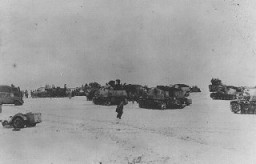
-
Subsequent Nuremberg Proceedings, Case #2: The Milch Case
ArticleThe Milch Case was Case #2 of 12 Subsequent Nuremberg Proceedings against leading German industrialists, military figures, SS perpetrators, and others.

-
Russian Revolution, 1917
ArticleThe Russian Revolution consisted of two separate revolutions in 1917: the February Revolution and the Bolshevik Revolution. Learn more.
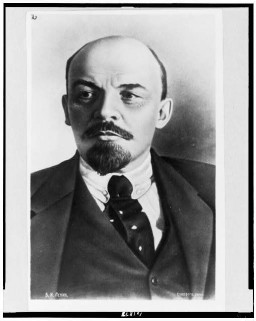
-
Bad Reichenhall Displaced Persons Camp
ArticleAfter WWII, many Holocaust survivors, unable to return to their homes, lived in displaced persons camps in Germany, Austria, and Italy. Read about Bad Reichenhall DP camp.

-
Explosion of the SS Patria
Timeline EventNovember 25, 1940. On this date, Egon Weiss survived the explosion of the SS Patria, which was carrying 1,800 Jewish refugees.
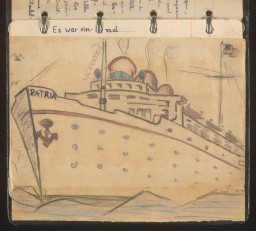
-
The 4th Infantry Division during World War II
ArticleThe 4th Infantry Division participated in major WWII campaigns and is recognized for liberating the Haunstetten subcamp of Dachau.
-
The United States and the Holocaust, 1942–45
ArticleWhy did the United States go to war? What did Americans know about the “Final Solution”? How did Americans respond to news about the Holocaust? Learn more.

-
German civilians from Schwarzenfeld dig graves for the reburial victims of a death march
PhotoGerman civilians from Schwarzenfeld dig graves for the reburial of 140 Hungarian, Russian, and Polish Jews exhumed from a mass grave near the town. The victims died while on an evacuation transport from the Flossenbürg concentration camp. Schwarzenfeld, Germany, April 25, 1945. Following the discovery of death march victims, US Army officers forced local Germans to view the scene of the crime and ordered the townspeople to give the victims a proper burial.
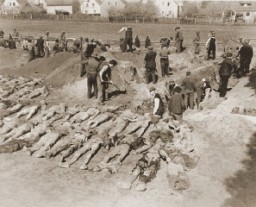
-
Portrait of members of the Freemasons Lodge of Chernovtsy, Bukovina
PhotoGroup portrait of members of the Freemasons Lodge of Chernovtsy, Bukovina, approximately 75 percent of whom were Jewish. The members were mainly intellectuals and leaders in business and local government. Among those pictured are Dr. Max Ennis (top row, third from the left); pharmacist, Dr. Abraham Guttman (top row, far right); an official in the revenue service, Dr. Max Gottfried (second row from the top, sixth from the left); and the judge, Dr. Jacob Rubel (third row from the top, far left). Chernovtsy,…
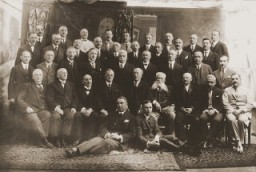
-
Amsterdam
ArticleLearn about Amsterdam during World War II and the Holocaust, including deportations of Jews to concentration camps and killing centers.
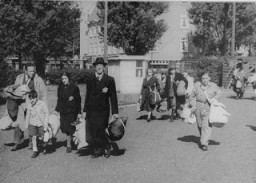
-
Paris
ArticleNazi Germany invaded Paris in May, 1940. Learn more about Paris during World War II and the fate of the Jewish population.
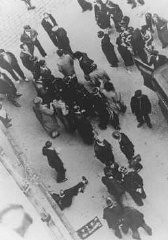
-
Norway
ArticleGermany invaded Norway on April 9, 1940. Read more about this invasion, the collaborator Vidkun Quisling, and the tragic fate of Norway’s Jews.
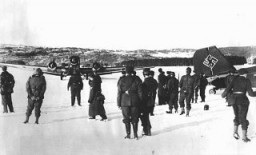
-
Subsequent Nuremberg Proceedings, Case #8, The RuSHA Case
ArticleThe RuSHA Case was Case #8 of 12 Subsequent Nuremberg Proceedings against leading German industrialists, military figures, SS perpetrators, and others.
